Food and Culture in Japan – Tradition Meets Modern Delights
Japan is a country that masterfully blends centuries-old traditions with cutting-edge modernity, and nowhere is this fusion more deliciously apparent than in its food and culture. From ancient tea ceremonies and time-honored culinary practices to the dazzling variety of street food and futuristic dining experiences, exploring the food and culture in Japan offers a unique and immersive way to understand the heart and soul of this fascinating nation.
This guide takes you on a journey through Japan’s most iconic traditional foods, modern gastronomic innovations, cultural rituals, and how they are interwoven to reflect the country’s rich identity.
Why Food and Culture in Japan Are Inseparable
In Japan, food is much more than mere sustenance—it’s a profound expression of history, spirituality, and regional identity. The meticulous presentation, seasonal ingredients, and ritualistic dining etiquette all reflect Japan’s cultural emphasis on harmony, respect, and beauty. The food and culture in Japan are deeply interconnected, offering not just a taste experience but a cultural immersion.
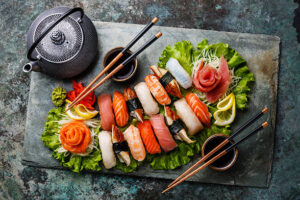
1. Sushi – The Art of Raw Perfection
Sushi is perhaps the most internationally renowned aspect of food and culture in Japan.
Highlights:
-
Variety: From nigiri (hand-pressed rice topped with fish) to maki rolls and chirashi bowls.
-
Etiquette: Sushi is often enjoyed with minimal soy sauce to appreciate the chef’s skill.
-
Omakase Experience: Let the chef decide the menu, offering a seasonal and curated experience.
Insider Tip:
Visit a local sushi bar where chefs prepare fresh sushi right in front of you for an authentic experience.
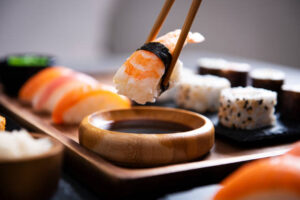
2. Ramen – Comfort Food with Regional Flavors
Ramen stands out in the list of essential food and culture in Japan, representing regional diversity and culinary craftsmanship.
Popular Variations:
-
Shoyu (Soy Sauce): Light and tangy, common in Tokyo.
-
Miso Ramen: Rich and hearty, popular in Hokkaido.
-
Tonkotsu (Pork Bone Broth): Creamy and flavorful, famous in Kyushu.
Travel Tip:
Visit a local ramen shop for an affordable and authentic meal. Some shops operate 24/7, offering a glimpse into Japan’s nocturnal food culture.
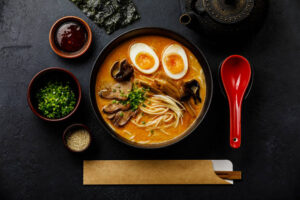
3. Kaiseki – The Pinnacle of Traditional Japanese Cuisine
Kaiseki is a multi-course meal reflecting the pinnacle of food and culture in Japan.
Highlights:
-
Seasonal Ingredients: Each dish represents the season’s best produce.
-
Artistic Presentation: Meals are meticulously plated to reflect nature and aesthetics.
-
Cultural Ritual: Kaiseki dining is a spiritual experience emphasizing respect and balance.
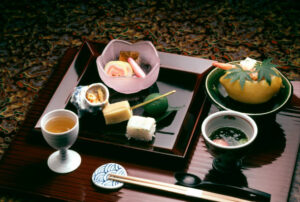
4. Street Food Culture – Quick, Tasty, and Cultural
Street food in Japan is a vibrant representation of modern-day food and culture in Japan.
Popular Street Food Items:
-
Takoyaki: Octopus-filled savory balls.
-
Okonomiyaki: Savory pancakes filled with vegetables, meat, or seafood.
-
Yaki Imo (Roasted Sweet Potato): Especially popular in winter.
Insider Tip:
Visit places like Osaka’s Dotonbori Street or Tokyo’s Asakusa district for an authentic street food experience.
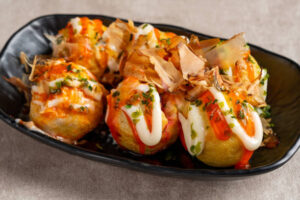
5. Tea Ceremony – A Cultural Ritual of Elegance
The traditional tea ceremony, or “Sado,” is one of the most symbolic practices in food and culture in Japan.
Highlights:
-
Chaji (Formal Tea Gathering): Lasts several hours and includes a full course of seasonal sweets and matcha.
-
Mindfulness and Respect: Every movement is deliberate, reflecting Zen philosophy.
-
Traditional Settings: Often held in tatami rooms with a view of a tranquil garden.
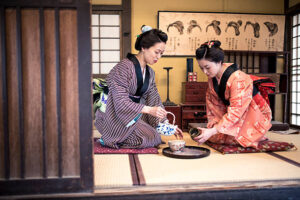
6. Japanese Festivals and Their Food – Matsuri Delights
During Japanese festivals, local foods are an essential part of the cultural experience.
Popular Festival Foods:
-
Kakigori (Shaved Ice): Refreshing in summer festivals.
-
Taiyaki: Fish-shaped cakes filled with sweet red bean paste.
-
Karaage (Fried Chicken): Served hot in festival stalls.
Cultural Connection:
Many festival foods have historical roots and are associated with local customs and celebrations.
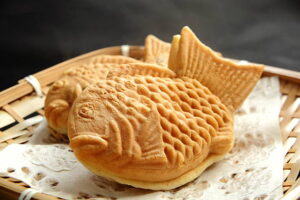
7. Sake and Local Beverages – The Drink Culture
Sake, Japan’s traditional rice wine, plays a central role in food and culture in Japan.
Highlights:
-
Varieties of Sake: Junmai, Ginjo, and Daiginjo, each with unique flavors.
-
Drinking Etiquette: It’s customary to pour sake for others rather than oneself.
-
Local Breweries: Some regions, like Niigata and Akita, are famous for sake production.
Insider Tip:
Participate in a sake-tasting tour for an immersive experience.
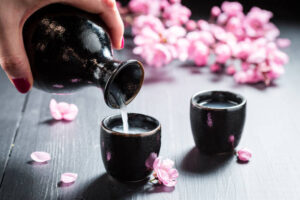
8. Modern Japanese Cuisine – Innovation Meets Tradition
Beyond tradition, Japan’s culinary scene embraces innovation while respecting its cultural roots.
Examples:
-
Fusion Cuisine: Sushi burritos and matcha tiramisu.
-
Themed Cafés: Robot cafés, cat cafés, and maid cafés offering playful experiences.
-
Michelin-Starred Restaurants: Cities like Tokyo boast the highest number of Michelin stars globally.
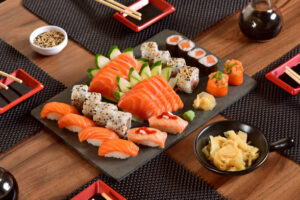
9. Regional Specialties – Taste the Diversity
Each region in Japan adds to the list of food and culture in Japan with its unique specialties.
Examples:
-
Hokkaido: Known for fresh seafood, dairy products, and ramen.
-
Kyoto: Famous for yudofu (tofu hot pot) and Kyoto-style kaiseki.
-
Okinawa: Known for goya champuru and unique sweet treats.
10. Rice – The Heart of Japanese Cuisine
Rice is the foundation of food and culture in Japan, with rituals and customs surrounding its preparation and consumption.
Highlights:
-
Varieties: Short-grain Japanese rice is prized for its stickiness.
-
Cultural Rituals: Rice planting and harvesting festivals honor the staple’s importance.
-
Traditional Dishes: Donburi (rice bowls), Onigiri (rice balls), and Mochi (rice cakes).
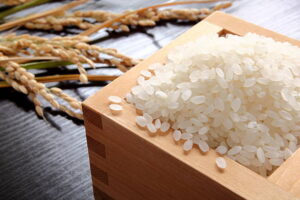
11. Japanese Desserts – Sweet Tradition and Modern Innovation
Japanese desserts reflect both food and culture in Japan.
Popular Desserts:
-
Mochi: Rice cakes filled with sweet red bean paste.
-
Dorayaki: Pancake sandwiches filled with sweet fillings.
-
Matcha Ice Cream: Green tea-flavored ice cream blending tradition with modern tastes.
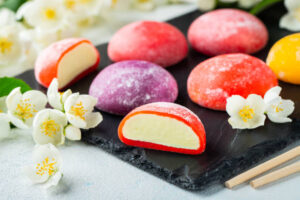
12. Dining Etiquette – Respecting the Tradition
Understanding Japanese dining etiquette is an essential part of experiencing food and culture in Japan.
Key Points:
-
Itadakimasu and Gochisousama: Phrases said before and after meals to express gratitude.
-
Chopstick Rules: Never stick chopsticks upright in rice or pass food from chopstick to chopstick.
-
Clean Presentation: Meals are carefully plated, and presentation is considered an art form.
13. Sustainable and Seasonal Eating – Shun Concept
A fundamental part of food and culture in Japan is the concept of “Shun,” focusing on seasonal eating.
Highlights:
-
Seasonal Ingredients: Emphasis on using ingredients at their peak.
-
Local Sourcing: Many dishes are prepared using locally sourced produce.
-
Sustainability: Reflects respect for nature and traditional practices.
Practical Travel Tips for Exploring Food and Culture in Japan
-
Language Tip: Learning basic food-related Japanese phrases can enhance your experience.
-
Cash is Preferred: Many local markets and small eateries don’t accept cards.
-
Tipping Culture: Tipping is not customary in Japan.
-
Timing Matters: Popular restaurants often open around peak meal times. Arriving early avoids long lines.
-
Cultural Sensitivity: Always remove shoes when entering traditional places.
Sample Food & Culture Itinerary in Japan
Day 1: Tokyo
-
Morning: Visit Tsukiji Outer Market for fresh seafood and sushi.
-
Afternoon: Explore Asakusa and enjoy street food like tempura and melon pan.
-
Evening: Participate in a tea ceremony at a traditional tea house.
Day 2: Kyoto
-
Morning: Experience kaiseki dining in a traditional ryokan.
-
Afternoon: Visit Nishiki Market and sample local specialties.
-
Evening: Explore Gion district with matcha sweets and local sake.
Day 3: Osaka
-
Morning: Visit Kuromon Market and enjoy takoyaki and okonomiyaki.
-
Afternoon: Explore Osaka Castle and local izakayas.
-
Evening: Enjoy a river cruise with local cuisine.
Conclusion – The Delicious Essence of Japan
The food and culture in Japan are inseparable, creating a rich, immersive experience that reflects the nation’s spirit. From centuries-old traditions like tea ceremonies and kaiseki to modern innovations like themed cafés and fusion cuisine, Japan offers something unforgettable for every food lover and cultural enthusiast. Embark on this delicious journey through Japan’s diverse landscapes, and let every meal and ritual connect you deeper to this fascinating country.
Start planning your adventure today and indulge in the rich food and culture in Japan for a truly memorable travel experience.
Follow Us: Instagram